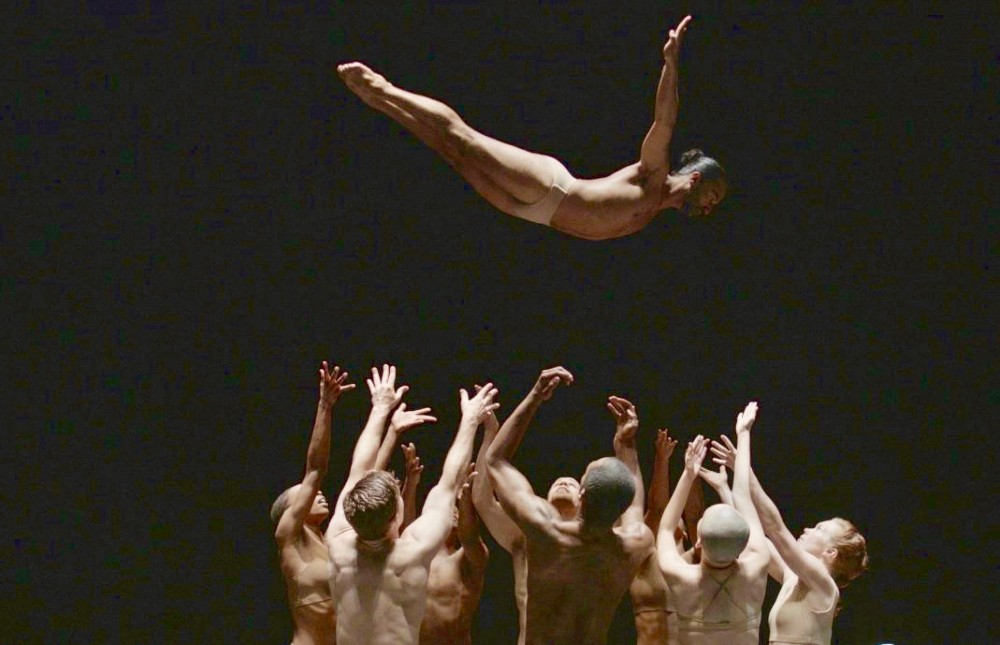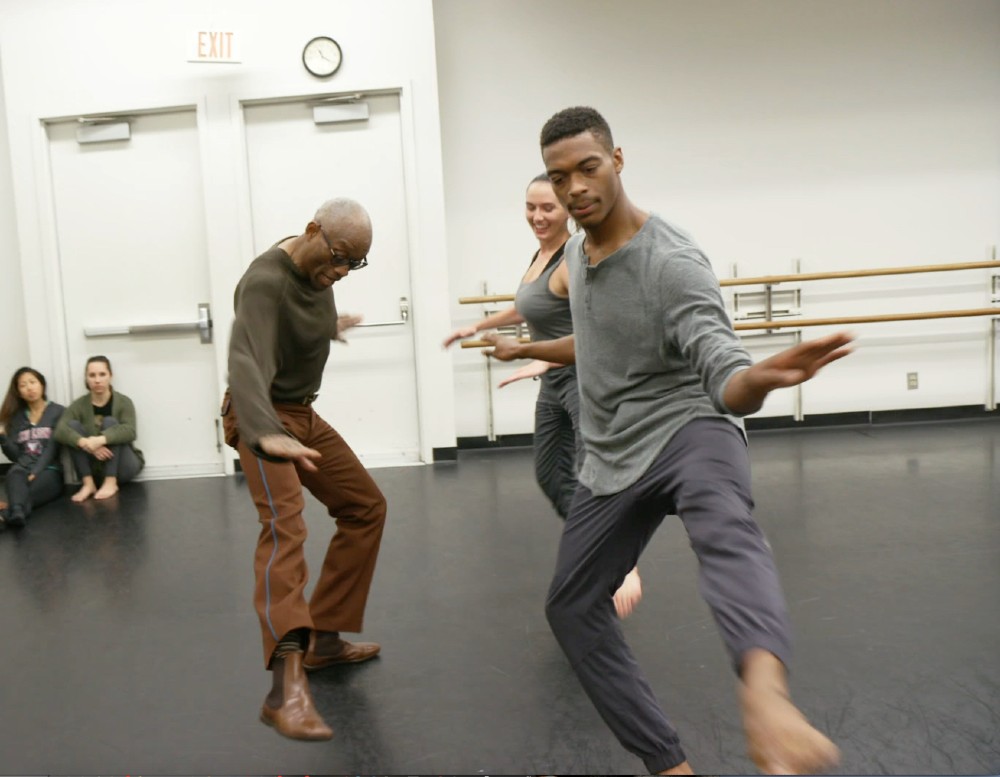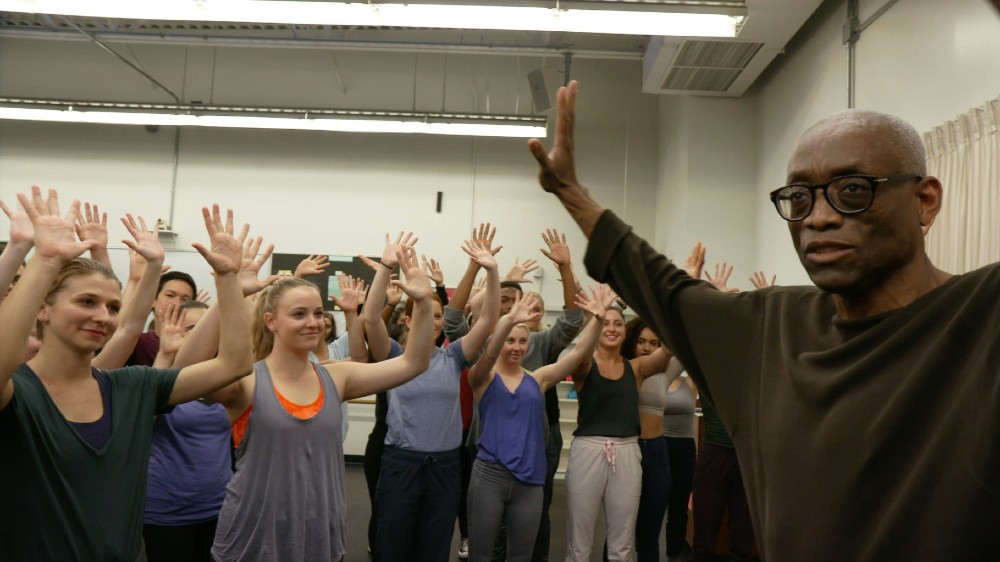
Cinematographer Tom Hurwitz, ASC is a bit of a legend within the world of documentary filmmaking, having been working within the medium since the mid-’60s and having shot or worked in camera for such classic docs as Harlan County, USA, No End in Sight, The Queen of Versailles, Koch, and dozens more.
His documentary directing has been somewhat more sporadic, but Hurwitz has teamed with dancer/instructor Rosalynde LeBlanc to co-direct Can You Bring It: Bill T. Jones and D-Man in the Waters, a film that examines iconic New York choreographer Bill T. Jones’ 1989 work, D-Man in the Waters, created at the height of the AIDS epidemic in New York, and its long-lasting influence on modern dance. The film cuts between interviews with Jones and the original company dancers who performed the work with footage of LeBlanc teaching a group of young dancers about the significance of said work.
Calling Can You Bring It a “dance movie” might be seen as a misnomer, though, because it’s about more than just that, as Hurwitz puts it himself, “We always say that this is not a dance film, it’s not an AIDS film. It’s a film about the human spirit and about art and the power of art.”
Below the Line got on Zoom to talk with Hurwitz about his amazing new film, which really transcends one’s own feelings about modern dance, telling a compelling story, not just about Bill T. Jones, his company and how the death of his lover and partner Arnie Zane from AIDS led to the creation of D-Man in the Waters, but also a portrait of the younger generation coming into dance.

Below the Line: I guess the first question is how did you meet Rosalynde [LeBlanc] and decide to make this movie together about this subject? You’ve shot a lot of documentaries, but I guess it’s been a while since you’ve directed one, and she had never directed a movie at all.
Tom Hurwitz: I direct every few years, and the experience that we had making this film tells me why I love to shoot, I love to collaborate, and so I’m happy to do that. Directing documentaries is a very long and painful process, having very little to do with the filmmaking. Doing this film was glorious, was a wonderful experience, almost uniformly all the way through, including the distribution. I mean, literally, the team on this film has been such a pleasure to work with from Day One. So Day One was Roz calling me on the telephone and asking me if I could shoot some interviews for her. Roz and I had met in 1992, when I directed the photography of the televising of one of Bill’s dances, Still/Here. We did that together. It was a long process. I spent several weeks with the company rehearsing and developing the images that would then be used when we filmed it in studio. And so I got to know Roz, I mean, not really well, because one doesn’t when you’re working all the time, but we did have a couple of conversations, so I knew that she was a really interesting person and a wonderful dancer. And so I followed her career. But we didn’t speak until she called me up on the telephone and asked me if I wanted to shoot these interviews. So we did, and as the story developed for me, I began to see that this was a much bigger project. There was a bigger story here than just how the dance happened. This was a really important film that could be made, and so we talked and met and decided to make it a feature film. That’s when we got started in about 2013.
BTL: So the original interviews were with the original dancers who performed “D-Man”?
Hurwitz: Yes, that’s right. That was the set of interviews. Roz was going to use it to transfer the story of the making of this dance to companies, on which she was going to put the dance, new younger companies, because with something that she felt, one, that the experience of the original making of the dance was really important for people to understand in the performing of the dance and the learning of the dance, new companies. Because the dance came out of such an extraordinarily powerful moment in our history and in the history of the artistic community, especially in the New York where, as one of the dancers said, half her phone book was dead. This was a period of deep tragedy and deep pain, and the role of the creation of this art in the preservation and the resurrection of the lives of this company was the story that came out of the interviews. When we got done shooting the interviews, I knew this was one of the best set of interviews I’ve ever shot in 40 to 50 years of filmmaking. I knew we had something very special.
BTL: I guess one of the benefits of being a cinematographer is you get to shoot all of this amazing stuff, and then someone else has to figure out what to use and cut it all down. Do you have an editor that you had worked with before that you wanted to use on this project?
Hurwitz: We had a great editor, but sit was she and I sitting in the editing room who figured that stuff out. But I couldn’t have done it without Ann Collins. She’s a magnificent editor, wonderful documentarian, with a great sense of structure. She’s just a great collaborator, so she and I, in a cutting room in New York for, I guess, almost a year to structure the film. It was tough film to structure, actually, because it takes place in two periods at once — it takes place during the AIDS crisis, when the original dance was being made, when Bill lost his partner Arnie Zane, both life partner and artistic partner, and then it takes place in the present. When the young company is learning the ballet. That’s a very subtle and difficult challenge to build a film that takes place in two times and interweaves between the two, so it was wonderful to have Anne with me doing it.

BTL: How did you go about finding the archival footage. Had you shot any of the original company doing the dance?
Hurwitz: I didn’t shoot any of the original of this particular dance, I had not shot at all. It was filmed twice, once really well in Paris with a lot of the original company doing it in the early 90s, like maybe 91. It was also filmed at the American Dance Festival in Durham, North Carolina, and I have a lot of problems with the way that was done, so we didn’t use it. We had wonderful archival help with the stuff that came out of the Bill T. Jones Company — they opened their archives to us, and that was terrific. From the New York Public Library and Daisy Palmer at the New York Public Library, terrific archival help. And then we had a wonderful archival advisor, Amy Schewel, who helped us find a lot of the historical material that fills out the film.
BTL: It’s an interesting counterpoint between how the original was shot and how you filmed the younger group while they’re learning the dance. How did you find this new group to follow? Was that something Roz had already done?
Hurwitz: Most of the dance that’s used in the film is dance that I shot by working with Roz, and that was the Bill T. Jones – Arnie Zane Company at the time we shot it in 2014-15, so the dance that kind of knits the film together and is the kind of expression of the feelings in the film, that dance is also stuff that we did. There’s a certain amount of archival footage of the original company — that’s just to set it in context — and then there’s the young company that Roz is teaching the dance to, and they were students. Roz is a professor at Loyola Marymount University in Los Angeles, and those were her students. As you see in the movie, there’s an open audition, so that the dance is cast from the available talent at the university. Roz is that extraordinary person who breathes life into these young dancers, that’s Roz.
BTL: But I still like that counterpoint between the older archival performance and how you shoot the younger dancers. I’ve never quite liked how dance is filmed on stage, usually just one stationary camera in the audience. It always feels very stiff.
Hurwitz: Even if it’s five cameras in the audience, it’s still not the way dance should be seen. Because when you see dance with your eyes, and you’re sitting in an audience, that doesn’t approximate what a camera sees. You can see close-ups and wide-shots at the same time. And you can figure out what you want to concentrate on and move your attention from one place to another where the dance draws you. So you’re interacting with the dance. When you film it, the camera then makes those decisions, and that’s a very, very different experience. You don’t experience movement the same way. So when I realized that our challenge was to film this dance, so that we could approximate the experience of the company doing the dance, which is so important, because that was so important to their lives, then I knew we had to film it in a new way. A lot of the dance is filmed on the stage, and that was a real challenge in terms of camera movement, and in terms of things like lighting, since we’re talking about the cinematography.

BTL: It makes you feel like you’re a part of this classroom. Is that always you shooting with a single camera? And is that hard to do while trying to stay out of the dancer’s way as they learn the dance?
Hurwitz: I had a second camera for one day. It was a very important day, the day that Bill was there, because I didn’t want to ever have to choose not to see him. So I had one camera on him when I wasn’t, but everything else was shot with one camera. Roz, when she was working with those kids over that period in the classroom, really couldn’t think about directing the film. She had to just concentrate on her task of working with those dancers.
BTL: That day when Bill visits the younger dancers is amazing to watch how they interact, how he listens to their issues and problems facing this younger generation vs. what he had been through in his life. I assume Bill was part of the original group of interviews, so he knew that this movie was being made, as well as the performers putting on the dance?
Hurwitz: Roz actually asked his permission to make the film before we ever got going, and he gave us his blessing, which was wonderful. And a lot of time to be interviewed, which was also wonderful. He’s an amazing character, but the time with the students themselves is the most poignant. I think everybody feels that.
BTL: Had you finished this before COVID, or were you still editing and doing post during COVID?
Hurwitz: I was in both the final color and the mix, the sound editing, all of that stuff was done during the COVID epidemic.
BTL: Did you have a way of doing it remotely, or were you both at a facility here in New York?
Hurwitz: Yeah, it was in New York. For the color work, we worked on the phone with a big monitor. I was at Technicolor and the color person, who was magnificent, was home working on her own set up there. I would see what she was doing on the big monitor at Technicolor, and then we would talk about it and move on. It was a wonderful week, but the mix, we all did in the studio together, masked and distanced.

BTL: I guess one of the nice aspects of being a cinematographer/director is that you’re more involved in the color DI, which is not something most directors might do, as it’s something the cinematographer might do to make sure it all looks good.
Hurwitz: We try to. I’ve worked with producers who think we’re gonna waste their money by taking too much time. When in fact, we save them money, because we know how to ask for the things that we need.
BTL: And it makes a huge difference in production values in terms of making something look more professional.
Hurwitz: The post on this film was a wonderful process, and really brought the film together in a really special way. The sound work, too, was a terrific team, really terrific.
BTL: I guess part of the challenge is trying to get the archival material to match with the current, present-day stuff. I guess everything you shot was digital?
Hurwitz: Yes, the shooting that we did was digital. Everything else, there was a little bit of everything, film and video, and different types of video.
BTL: What’s your camera of choice when filming this?
Hurwitz: Well, for this job, my camera was a C300. I think I moved from a Mark I to a Mark II in the middle of the production. The reason why is the ergonomics of the camera. I don’t like a camera that has to be built out, that can only work if it has all kinds of stuff hanging on it, monitors and various drives and controls and all kinds of stuff. It makes it heavy and unwieldy. When you’re shooting dance, you need “wieldy,” and the C300, it is a beautifully designed cam. As it’s gotten older and with different iterations of it, it’s become heavier and a little bit bulkier and less economically beautiful, but the original was gorgeous camera, and the color was wonderful. Everyone who worked with it, the engineers, everybody, loved the material it was producing.
BTL: I imagine you have to be able to move almost as gracefully as a dancer to capture some of it without being in the way.
Hurwitz: I should say that for the shooting of the professional company doing the dance. For that piece, we used Alexa, because we needed it for the slow motion, and we used another C300 on a Movi for some of the work on stage around the dancers. And then some of it was hand-held.
BTL: What did Bill think when he saw the movie? I assume he’s seen it?
Hurwitz: Yes, he loves it. Bill gave us one note — since we’re talking below the line — and it’s the best note I’ve ever been given by the subject of the film. We sat down at dinner afterwards, and he said, “You know, we’ve been thinking, and the beginning of the film, it takes a little while to get into it, to see why this is important to watch. Maybe there’s something you can do to build a different beginning or a better beginning of the film. The editor and I looked at each other, and we both went “UH-HUH.” Because the two hardest things to do when you’re making a documentary are beginning it and ending it. You’d be amazed at how many films don’t do either one of those things. So we went back in and we did some thinking, and we made a beginning that was strong and told people why they should be interested in watching this film.
Can You Bring It: Bill T. Jones and D-Man in the Waters will open theatrically at New York’s Film Forum on Friday, July 16, but it will also be available to watch via Virtual Cinema nationwide.
All photos courtesy Rosalynde LeBlanc, except where noted.





